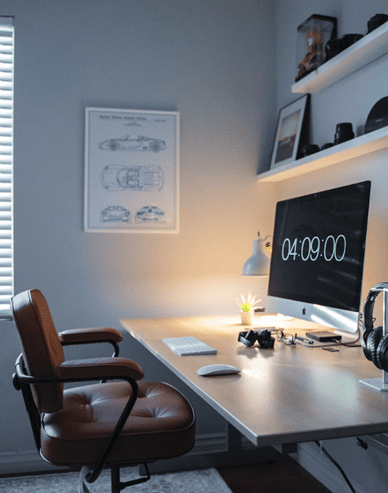Creating a comfortable and functional home office is essential for those who work from home. A well-decorated workspace can increase productivity and make the workday more enjoyable. However, decorating a home office can be overwhelming, especially for those who are not design-savvy.
Luckily, there are many tips and tricks that can help transform a bland home office into a beautiful and functional workspace. From choosing the right color scheme to incorporating storage solutions, there are many ways to make a home office both aesthetically pleasing and practical. This article will provide readers with some simple and effective home office decoration tips that they can use to enhance their workspace.
- Furniture Selection
- Lighting Options
- Decorative Elements
1. Furniture Selection
When setting up a home office, selecting the right furniture is crucial. It not only affects the overall look and feel of the space but also plays a significant role in productivity and comfort. Here are some tips for selecting the right furniture for your home office.
Choosing a Desk
The desk is the centerpiece of any home office. When selecting a desk, consider the size of your workspace, the type of work you do, and your personal preferences. Some popular options include:
- Standing Desk: A standing desk allows you to work while standing, which can help improve posture and reduce back pain.
- L-Shaped Desk: An L-shaped desk provides ample workspace and is ideal for those who need to multitask or work on multiple projects at once.
- Writing Desk: If you only need a desk for basic tasks like writing or using a laptop, a writing desk may be the perfect option.
Picking Comfortable Seating
When it comes to seating, comfort should be your top priority. Consider the amount of time you’ll be spending in your chair and the type of work you’ll be doing. Some options to consider include:
- Ergonomic Chair: An ergonomic chair is designed to support your spine and reduce back pain. Look for chairs with adjustable seat height and lumbar support.
- Swivel Chair: A swivel chair is ideal for those who need to move around their workspace frequently.
- Stool: If you prefer to work while standing, a stool can provide a comfortable place to rest your feet.
Storage Solutions
Storage is another important consideration when selecting furniture for your home office. You’ll need a place to store files, books, and other office supplies. Some options to consider include:
- Filing Cabinet: A filing cabinet is ideal for storing paperwork and other documents.
- Bookcase: A bookcase can provide ample storage space for books and other items.
- Shelving Unit: A shelving unit is a versatile storage solution that can be used to store a variety of items.
2. Lighting Options
Natural Light Maximization
When it comes to home office decoration, natural light is the most desirable option. A well-lit room can enhance mood, increase productivity, and reduce eye strain. To maximize natural light, consider the following tips:
- Position the desk near the window to allow for natural light to fall on it.
- Use light-colored curtains or blinds that allow natural light to pass through.
- Keep the window clean to prevent dust and dirt from blocking the light.
Artificial Lighting Choices
Artificial lighting is necessary for home offices that lack natural light or for those who work during the night. Here are some artificial lighting options to consider:
- Overhead lighting: This type of lighting provides general illumination to the room. Consider installing LED lights as they are energy-efficient and have a longer lifespan.
- Task lighting: This type of lighting is designed to illuminate a specific area where work is being done, such as a desk lamp. LED task lighting is also a great option as it provides bright and focused light without producing heat.
- Accent lighting: This type of lighting is used to highlight a specific area or object in the room, such as a piece of artwork or a bookshelf. Accent lighting can be achieved through the use of spotlights or wall sconces.
In conclusion, a well-lit home office is crucial for productivity and overall well-being. By maximizing natural light and choosing appropriate artificial lighting options, one can create a comfortable and efficient workspace.
3. Decorative Elements
When it comes to decorating a home office, adding decorative elements can make a big difference in creating a comfortable and inspiring workspace. Here are some ideas for incorporating decorative elements into your home office.
Moss and Living Walls
Moss and living walls are a unique way to add greenery to a home office. They can help purify the air and create a calming atmosphere. Moss walls are low-maintenance and can be installed on any wall. Living walls require more upkeep but can be a beautiful addition to any space.
Rugs and Curtains
Rugs and curtains can add warmth and texture to a home office. A rug can define a workspace and make it feel more inviting. Curtains can provide privacy and help control the amount of natural light in the room. Consider choosing rugs and curtains that complement the existing decor and color scheme. Incorporating decorative elements into a home office can make it a more comfortable and inspiring space. Whether it’s adding wall decor, moss walls, or rugs and curtains, there are many ways to personalize a workspace.

